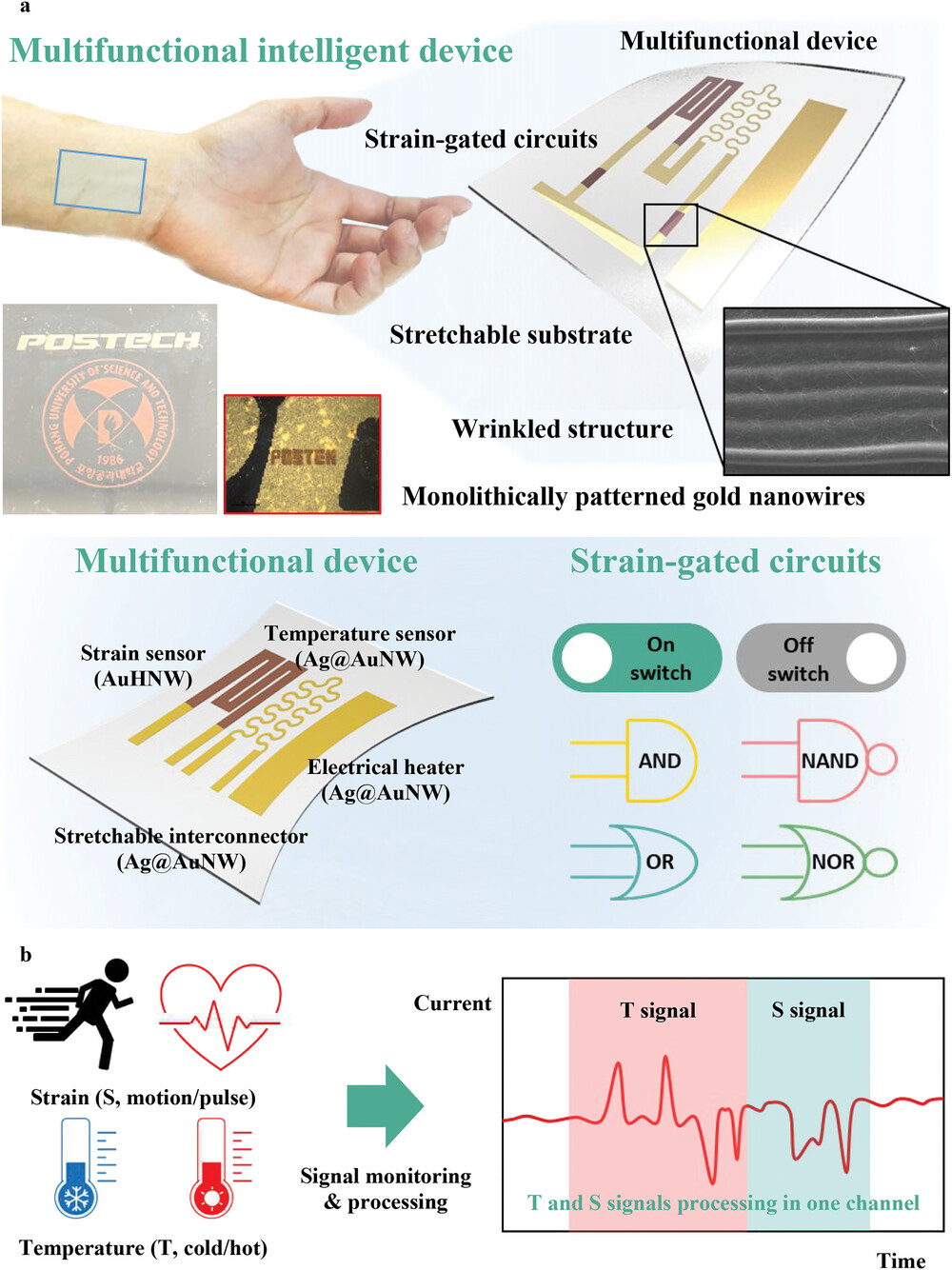| Nov 20, 2023 |
|
(Nanowerk News) Wearable electronics that can monitor health and provide real-time feedback have long been envisioned as the future of personalized medicine. But most wearables today simply collect raw data to be processed later. Now, researchers have developed stretchable, multifunctional circuits made from gold nanowires that can both sense health signals directly on the skin and process that data in real time without external algorithms or rigid chips. This breakthrough could enable rapid advancements in smart wearables able to detect concerning health changes and intervene with treatments like heat or light therapy as needed.
|
|
The vision for healthcare wearables has been sensors that could track vital signs and biomarkers, then autonomously activate treatments in response. But most research has focused just on monitoring, with little progress in real-time on-board processing. Existing conductive materials for stretchable electronics also have limitations in stability and biocompatibility that constrain medical uses. And attempts to integrate rigid silicon chips with flexible sensors have achieved only partial stretchability due to mechanical mismatch.
|
|
According to Dr. Sei Kwang Hahn of Pohang University of Science and Technology, developing a single material for both robust stretchable circuits and on-board logic operations could be the game-changer for smart wearables. His team pursued innovative nanowire structures in pursuit of this goal.
|
|
The findings have been published in Advanced Materials (“Multifunctional Intelligent Wearable Devices Using Logical Circuits of Monolithic Gold Nanowires”).
|
 |
| Schematic illustration for multifunctional intelligent wearable devices. a) Sensor systems and strain-gated circuits using monolithically patterned gold nanowires and microwrinkle structures. b) Multifunctional intelligent wearable devices for both signal monitoring and processing simultaneously. (Reprinted with permission by Wiley-VCH Verlag)
|
|
The team developed techniques to synthesize and pattern two types of gold nanowires using a combination of galvanic growth and selective etching. This yielded gold nanowires in both hollow and filled forms. The filled gold-silver core-shell nanowires provided high conductivity with lower sensitivity to strain. In contrast, the hollow gold nanowires were more strain sensitive but less conductive.
|
|
By integrating both nanowire types into monolithic circuits, Hahn’s team created a multifunctional platform able to sense temperature, strain and other signals while also performing logical operations. The filled gold nanowires served as interconnects and temperature sensors, while the hollow gold nanowires operated as strain gauges.
|
|
Remarkably, adjusting the nanowire geometry also enabled strain-gated switches, where strain either increased or decreased conductivity. Connecting these switches allowed construction of logical circuits performing AND, OR, NAND and NOR operations. The researchers used these circuits to demonstrate capabilities like activating sensors and routing their signals for further processing.
|
|
Such seamless integration of diverse components was only possible due to the monolithic nanowire patterning technique. This overcame integration challenges that have long constrained multifunctional wearables. Preventing mechanical failures at interfaces between materials with mismatched properties has been an enduring problem. But combining compatible nanowire types into single-structure circuits minimized such concerns.
|
|
Compared to pure silver or copper nanowire alternatives, the gold composite structures also provided much higher chemical stability for biomedical uses. And unlike attempts to incorporate silicon chips, all components remained fully stretchable, twisting and deforming without damage.
|
|
According to Dr. Hahn, their platform has many promising applications, like a smart wound dressing that monitors strain on a healing injury. It could detect excessive swelling and automatically heat the area to stimulate healing. Or a smart contact lens that monitors ocular strain and provides cues when it’s time to blink and prevent dryness.
|
|
But the most revolutionary possibilities are autonomous wearable treatments. For example, a patch placed over a tumor that can sense the increasing strain from its growth. Once large enough, it could initiate targeted hyperthermic therapy. This closed feedback loop enabled by real-time processing takes personalized medicine a major leap forward. It also opens possibilities like unobtrusive implants to monitor and regulate organ function.
|
|
However, many challenges remain before such bold applications become practical. While highly promising, the stability and biocompatibility of these multifunctional nanowire circuits must still be rigorously assessed. Their capabilities also need to be pushed to industrial manufacturing scales for commercialization. And supervising such autonomous healthcare wearables via fail-safes and external override will require extensive regulatory work.
|
|
Nonetheless, this research represents a true paradigm shift. Dr. Hahn emphasized that their single material system for both sensing and processing could be a game-changer for wearable electronics. And it exemplifies how synthesizing tailored nanomaterials allows reinventing fundamental components to overcome seemingly intractable obstacles. Just like integrated circuits enabled the computer revolution, these stretchable multifunctional circuits could spark the real-time responsive healthcare wearables transformation.
|
- SEO Powered Content & PR Distribution. Get Amplified Today.
- PlatoData.Network Vertical Generative Ai. Empower Yourself. Access Here.
- PlatoAiStream. Web3 Intelligence. Knowledge Amplified. Access Here.
- PlatoESG. Carbon, CleanTech, Energy, Environment, Solar, Waste Management. Access Here.
- PlatoHealth. Biotech and Clinical Trials Intelligence. Access Here.
- Source: https://www.nanowerk.com/nanotechnology-news2/newsid=64083.php




